TOYOTA AURIS HYBRID 2012 Owners Manual
Manufacturer: TOYOTA, Model Year: 2012, Model line: AURIS HYBRID, Model: TOYOTA AURIS HYBRID 2012Pages: 524, PDF Size: 26.34 MB
Page 421 of 524
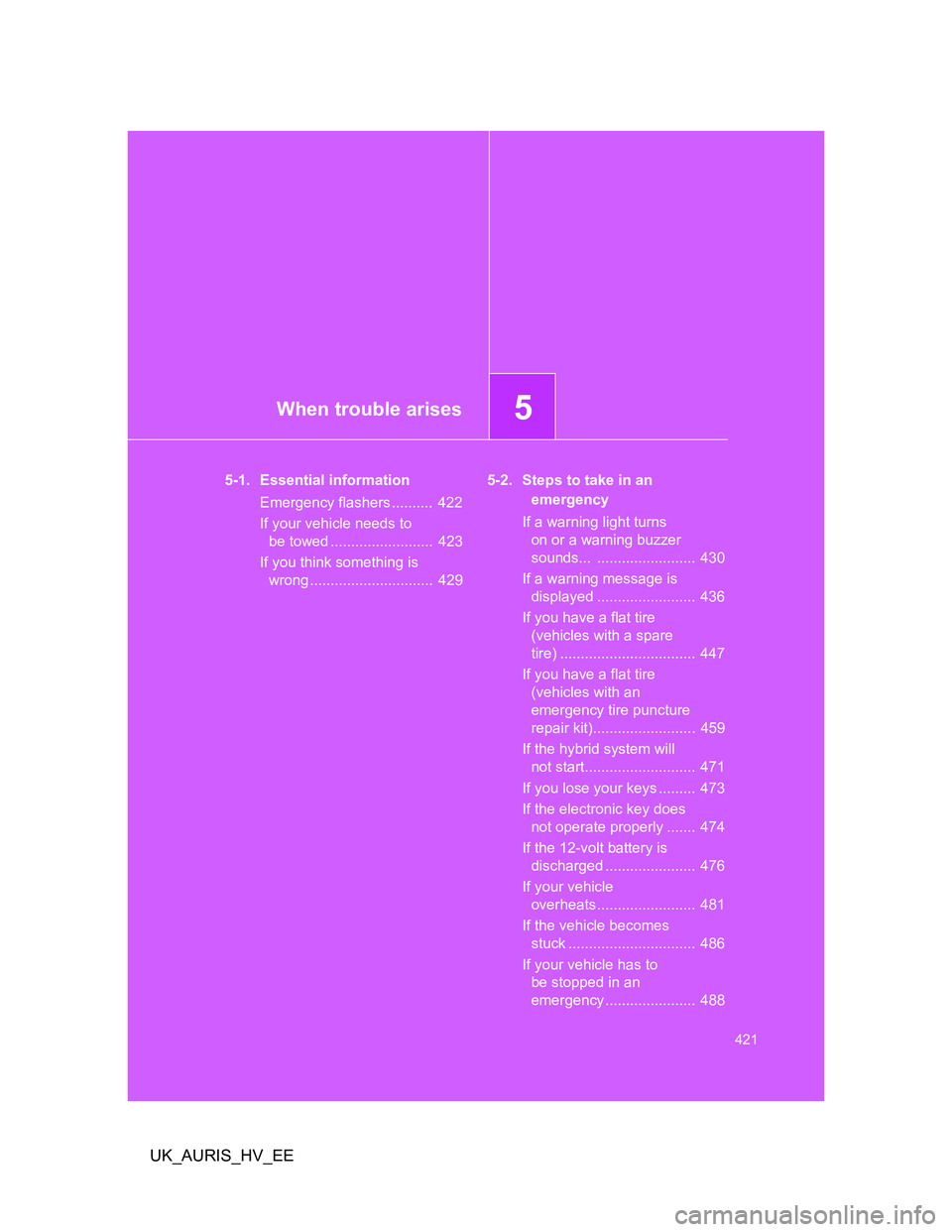
5When trouble arises
421
UK_AURIS_HV_EE
5-1. Essential information
Emergency flashers .......... 422
If your vehicle needs to
be towed ......................... 423
If you think something is
wrong .............................. 4295-2. Steps to take in an
emergency
If a warning light turns
on or a warning buzzer
sounds... ........................ 430
If a warning message is
displayed ........................ 436
If you have a flat tire
(vehicles with a spare
tire) ................................. 447
If you have a flat tire
(vehicles with an
emergency tire puncture
repair kit)......................... 459
If the hybrid system will
not start........................... 471
If you lose your keys ......... 473
If the electronic key does
not operate properly ....... 474
If the 12-volt battery is
discharged ...................... 476
If your vehicle
overheats ........................ 481
If the vehicle becomes
stuck ............................... 486
If your vehicle has to
be stopped in an
emergency ...................... 488
Page 422 of 524
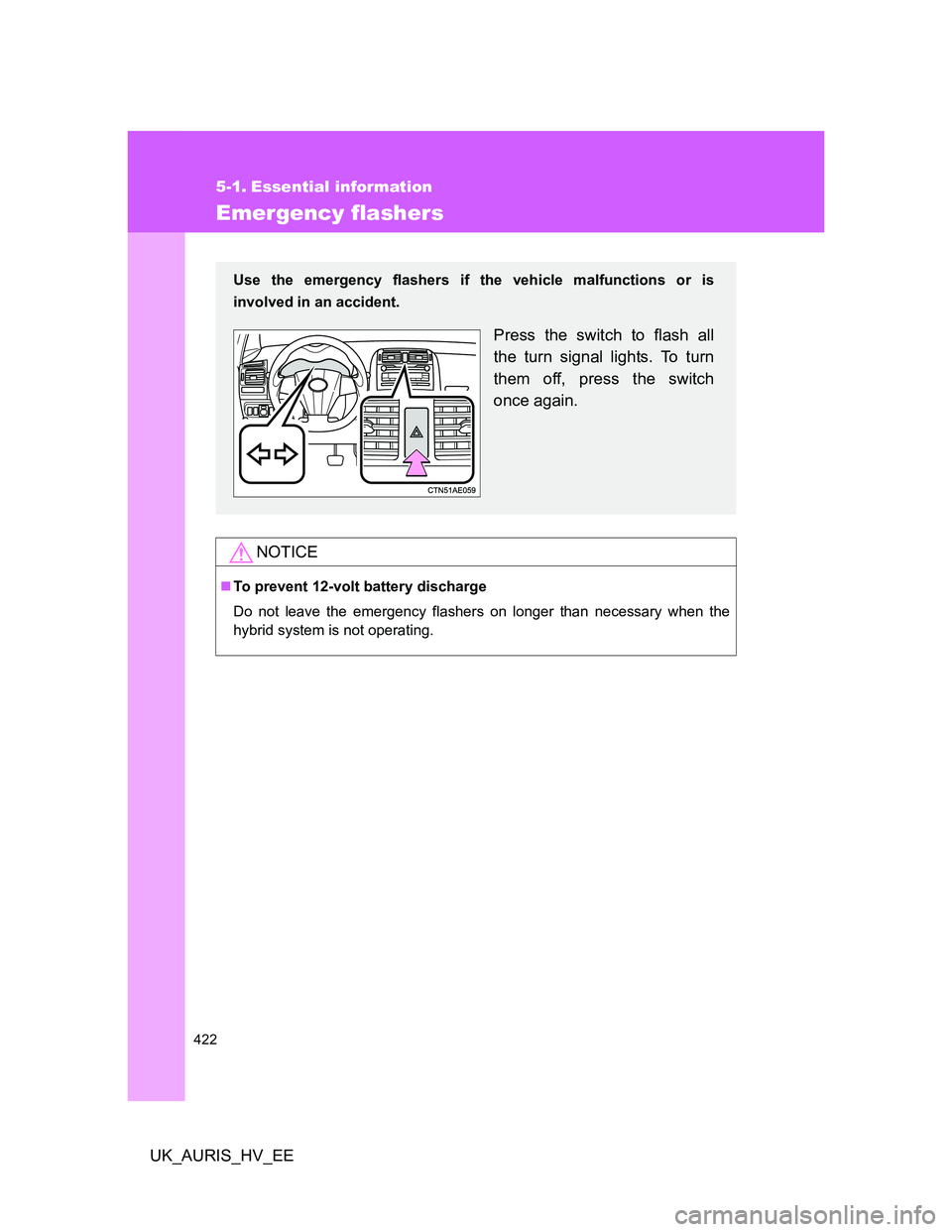
422
UK_AURIS_HV_EE
5-1. Essential information
Emergency flashers
NOTICE
To prevent 12-volt battery discharge
Do not leave the emergency flashers on longer than necessary when the
hybrid system is not operating.
Use the emergency flashers if the vehicle malfunctions or is
involved in an accident.
Press the switch to flash all
the turn signal lights. To turn
them off, press the switch
once again.
Page 423 of 524
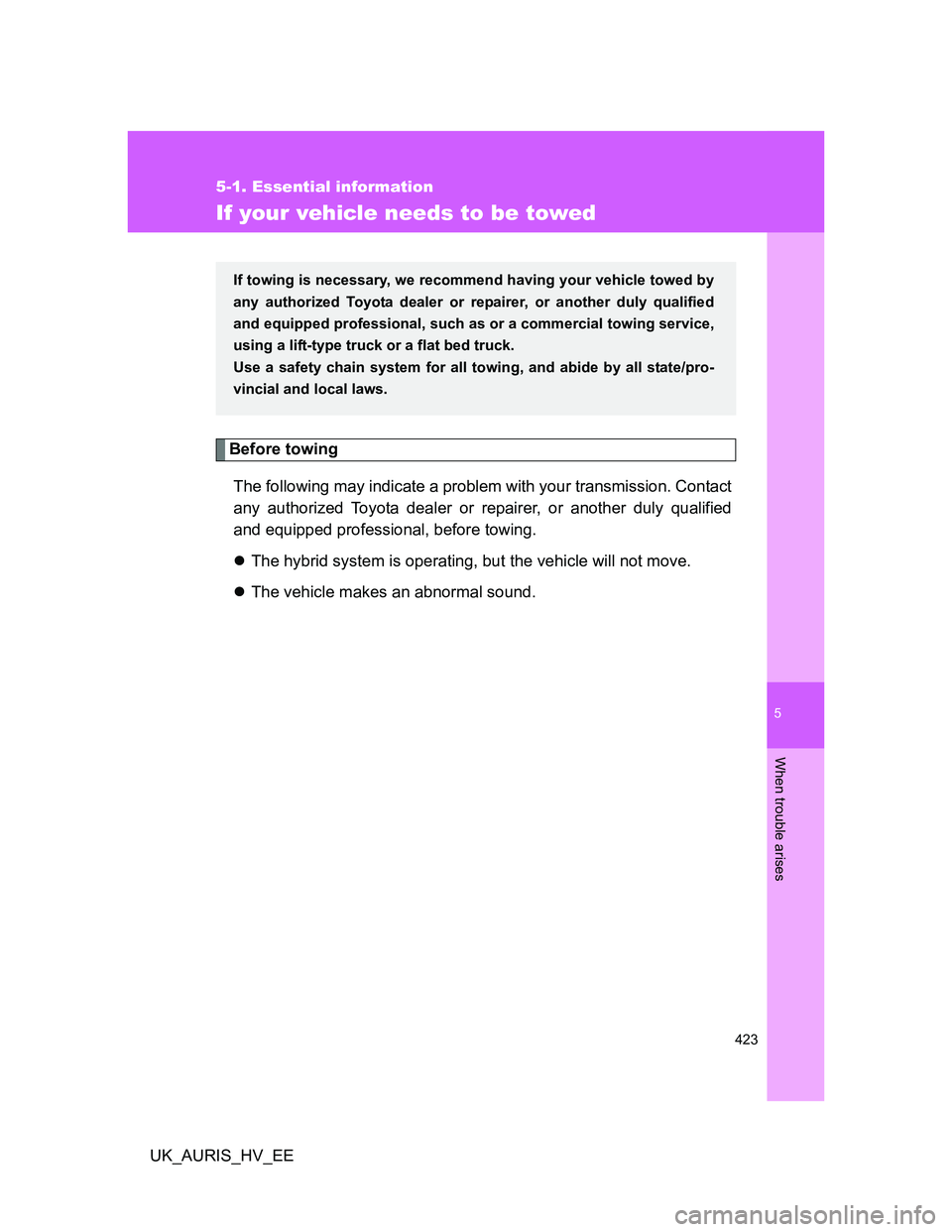
5
423
5-1. Essential information
When trouble arises
UK_AURIS_HV_EE
If your vehicle needs to be towed
Before towing
The following may indicate a problem with your transmission. Contact
any authorized Toyota dealer or repairer, or another duly qualified
and equipped professional, before towing.
The hybrid system is operating, but the vehicle will not move.
The vehicle makes an abnormal sound.
If towing is necessary, we recommend having your vehicle towed by
any authorized Toyota dealer or repairer, or another duly qualified
and equipped professional, such as or a commercial towing service,
using a lift-type truck or a flat bed truck.
Use a safety chain system for all towing, and abide by all state/pro-
vincial and local laws.
Page 424 of 524
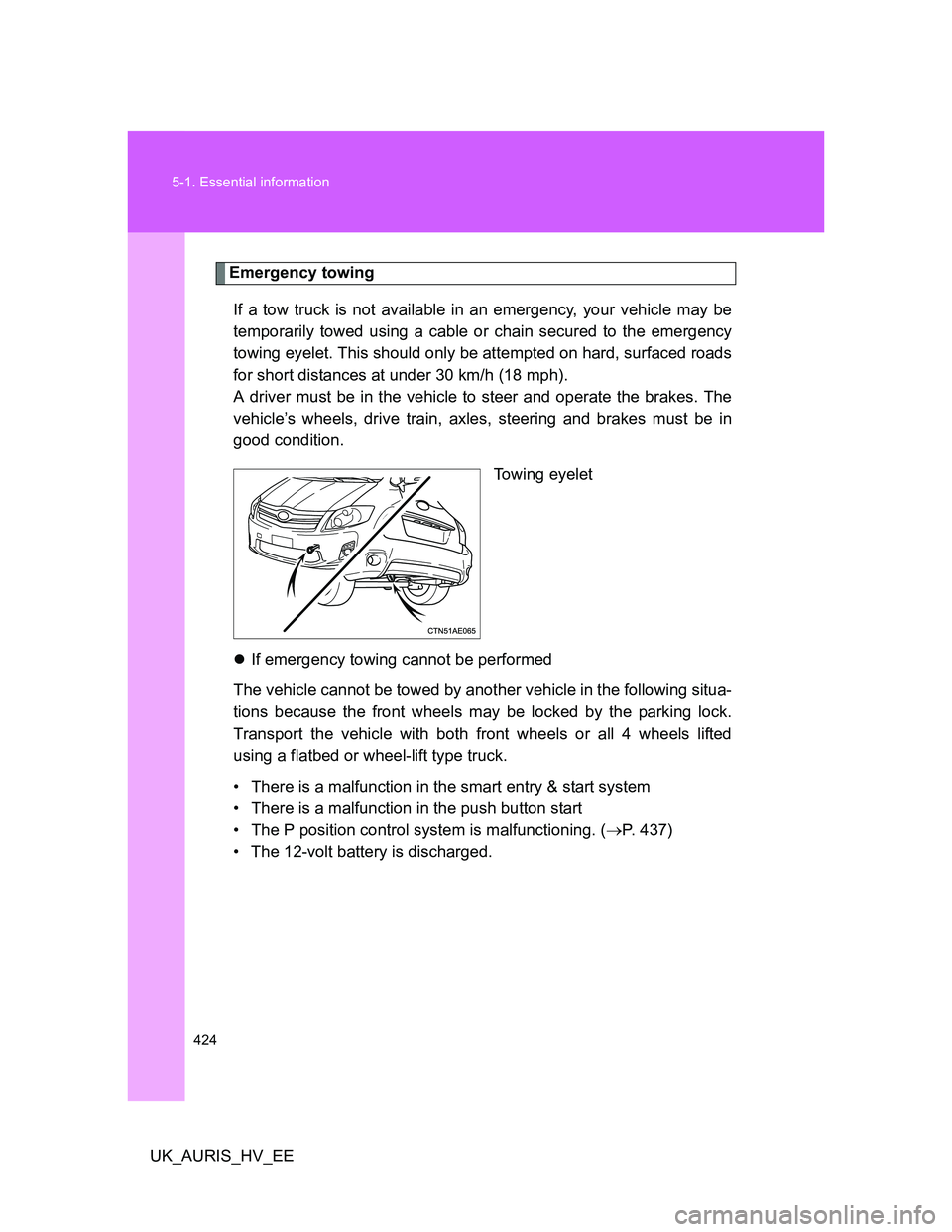
424 5-1. Essential information
UK_AURIS_HV_EE
Emergency towing
If a tow truck is not available in an emergency, your vehicle may be
temporarily towed using a cable or chain secured to the emergency
towing eyelet. This should only be attempted on hard, surfaced roads
for short distances at under 30 km/h (18 mph).
A driver must be in the vehicle to steer and operate the brakes. The
vehicle’s wheels, drive train, axles, steering and brakes must be in
good condition.
Towing eyelet
If emergency towing cannot be performed
The vehicle cannot be towed by another vehicle in the following situa-
tions because the front wheels may be locked by the parking lock.
Transport the vehicle with both front wheels or all 4 wheels lifted
using a flatbed or wheel-lift type truck.
• There is a malfunction in the smart entry & start system
• There is a malfunction in the push button start
• The P position control system is malfunctioning. (P. 437)
• The 12-volt battery is discharged.
Page 425 of 524
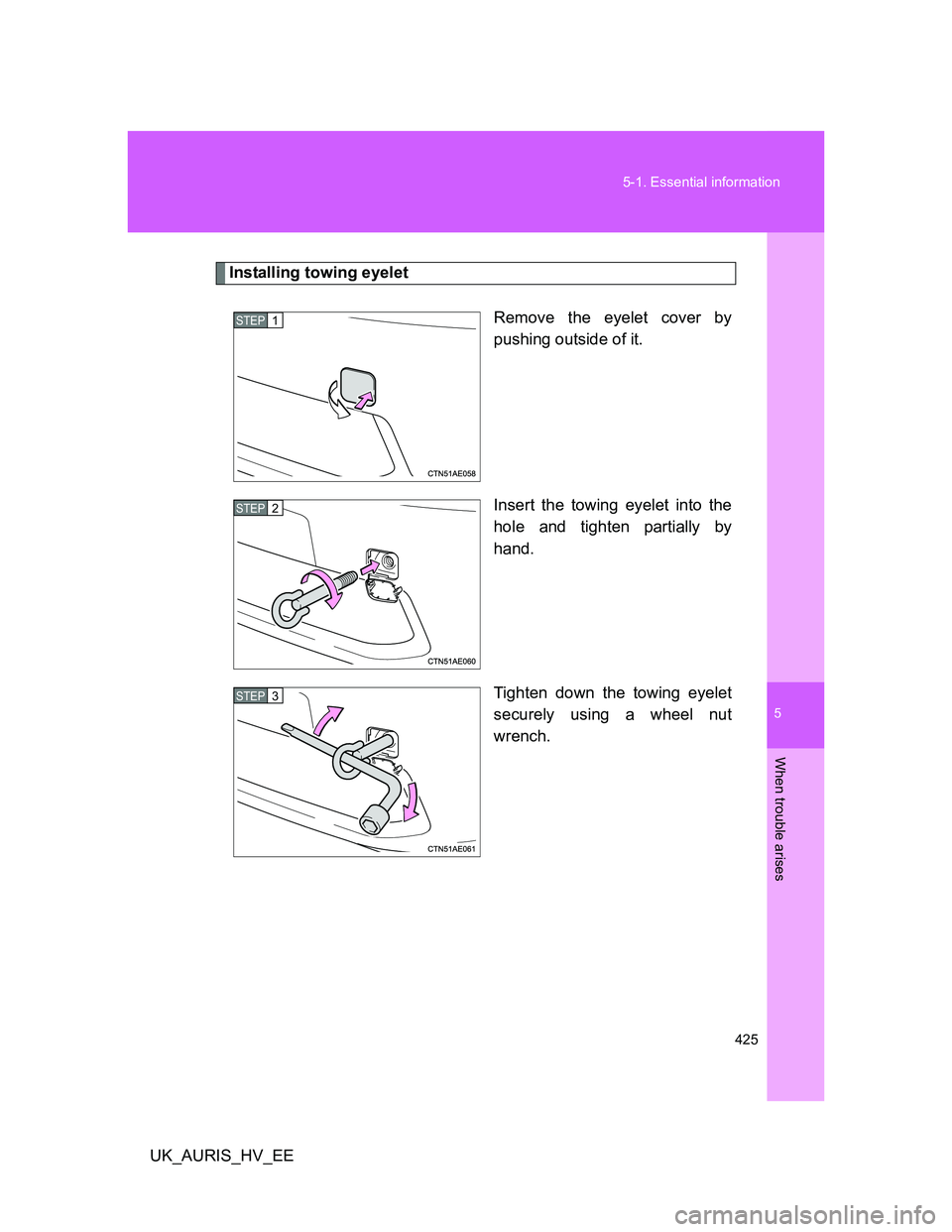
5
425 5-1. Essential information
When trouble arises
UK_AURIS_HV_EE
Installing towing eyelet
Remove the eyelet cover by
pushing outside of it.
Insert the towing eyelet into the
hole and tighten partially by
hand.
Tighten down the towing eyelet
securely using a wheel nut
wrench.
STEP1
STEP2
STEP3
Page 426 of 524
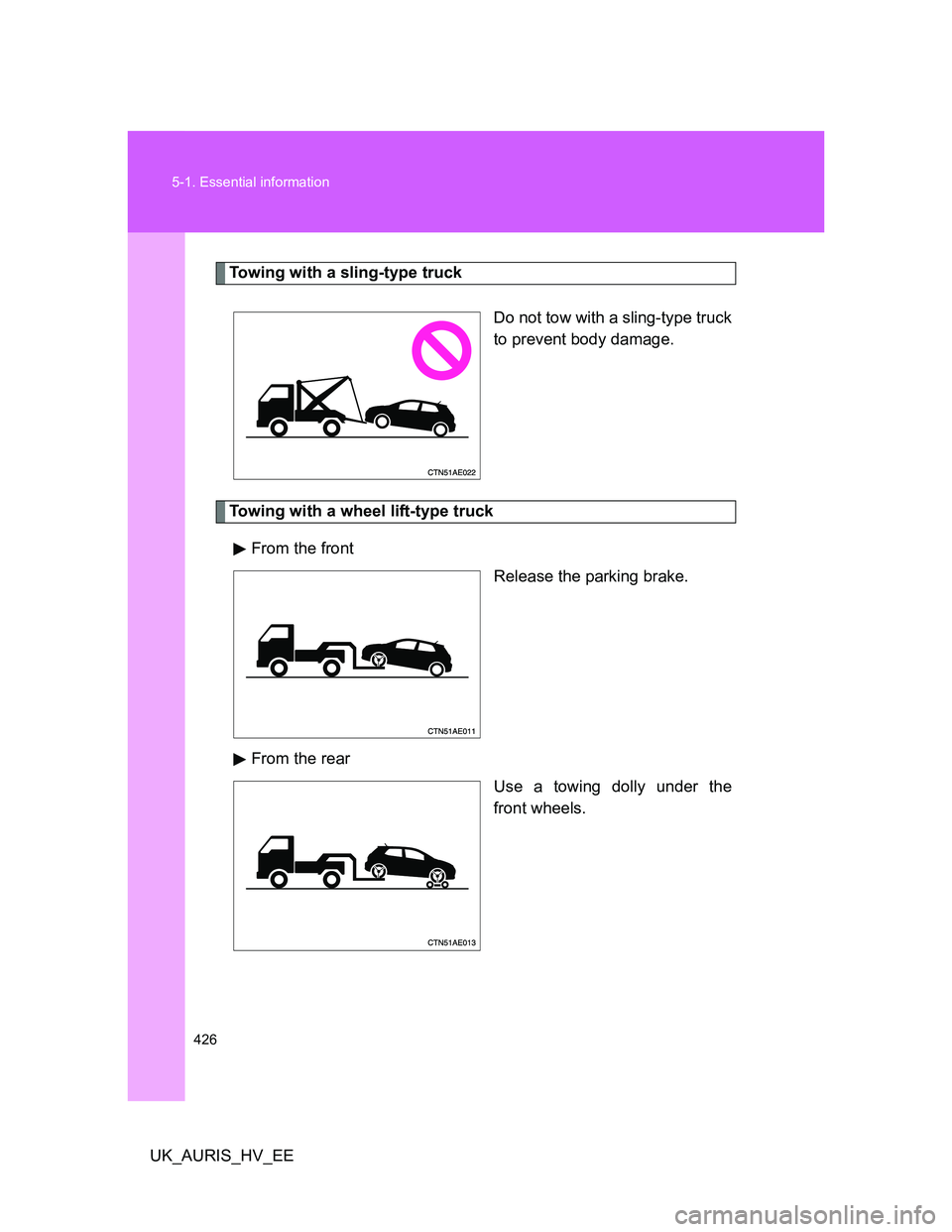
426 5-1. Essential information
UK_AURIS_HV_EE
Towing with a sling-type truck
Do not tow with a sling-type truck
to prevent body damage.
Towing with a wheel lift-type truck
From the front
Release the parking brake.
From the rear
Use a towing dolly under the
front wheels.
Page 427 of 524
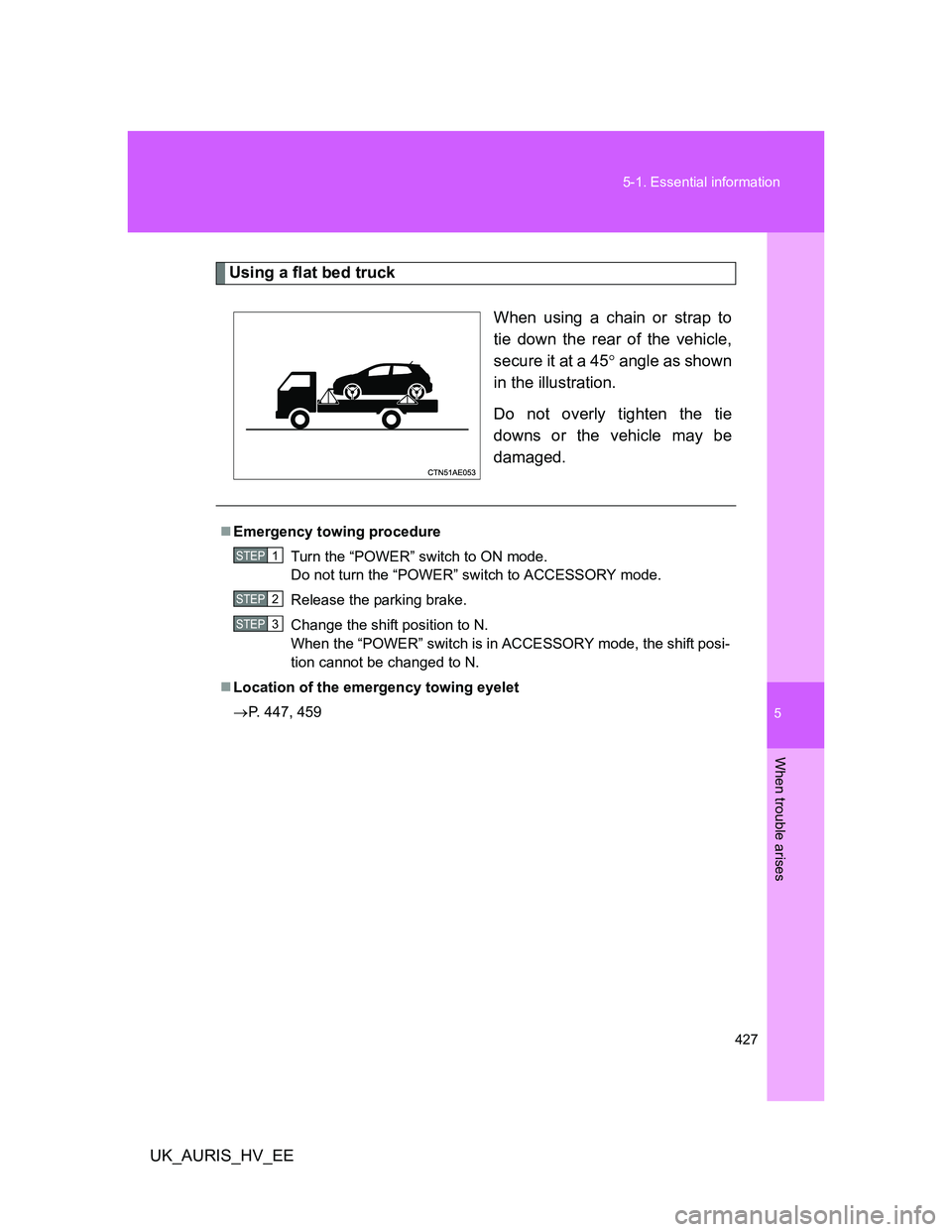
5
427 5-1. Essential information
When trouble arises
UK_AURIS_HV_EE
Using a flat bed truck
When using a chain or strap to
tie down the rear of the vehicle,
secure it at a 45 angle as shown
in the illustration.
Do not overly tighten the tie
downs or the vehicle may be
damaged.
Emergency towing procedure
Turn the “POWER” switch to ON mode.
Do not turn the “POWER” switch to ACCESSORY mode.
Release the parking brake.
Change the shift position to N.
When the “POWER” switch is in ACCESSORY mode, the shift posi-
tion cannot be changed to N.
Location of the emergency towing eyelet
P. 447, 459
STEP1
STEP2
STEP3
Page 428 of 524
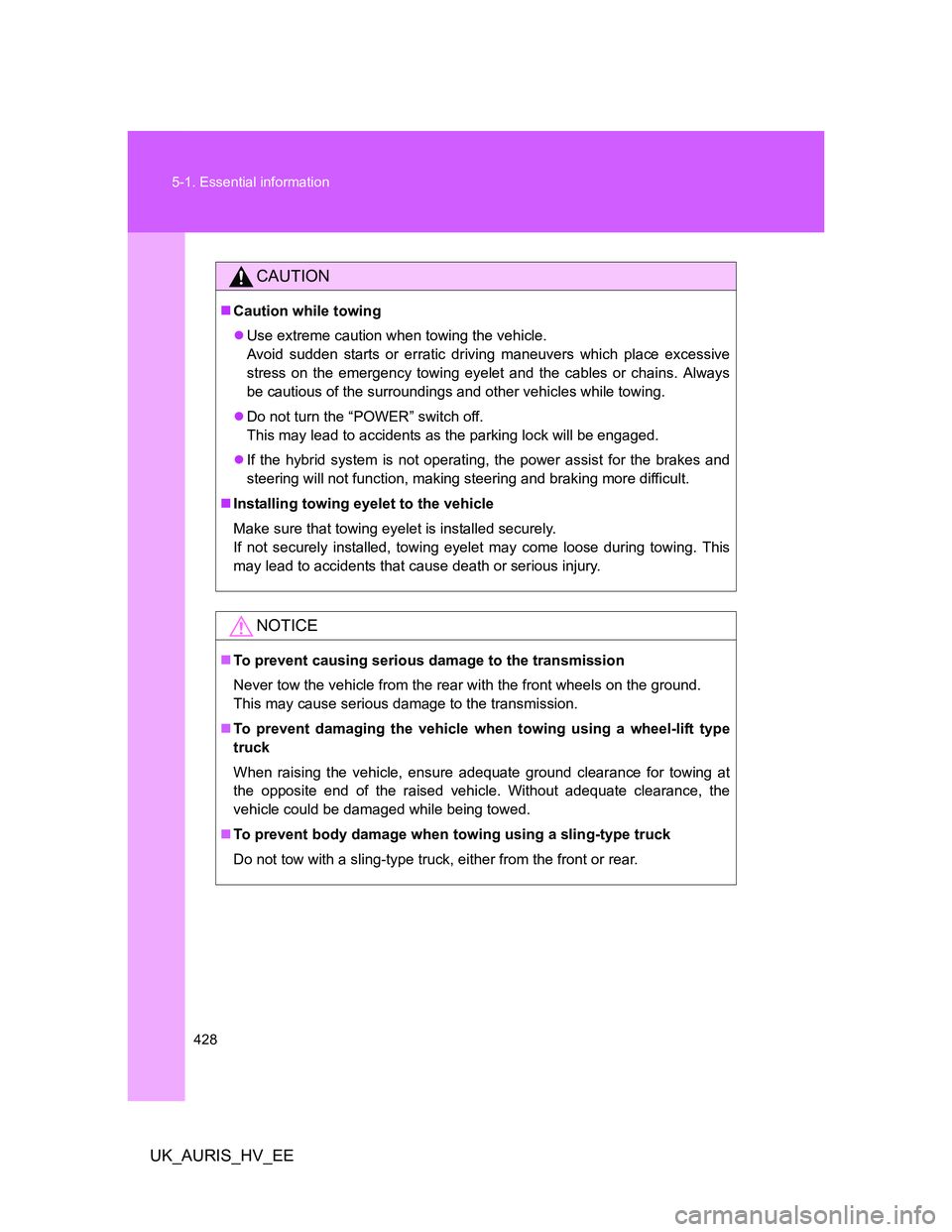
428 5-1. Essential information
UK_AURIS_HV_EE
CAUTION
Caution while towing
Use extreme caution when towing the vehicle.
Avoid sudden starts or erratic driving maneuvers which place excessive
stress on the emergency towing eyelet and the cables or chains. Always
be cautious of the surroundings and other vehicles while towing.
Do not turn the “POWER” switch off.
This may lead to accidents as the parking lock will be engaged.
If the hybrid system is not operating, the power assist for the brakes and
steering will not function, making steering and braking more difficult.
Installing towing eyelet to the vehicle
Make sure that towing eyelet is installed securely.
If not securely installed, towing eyelet may come loose during towing. This
may lead to accidents that cause death or serious injury.
NOTICE
To prevent causing serious damage to the transmission
Never tow the vehicle from the rear with the front wheels on the ground.
This may cause serious damage to the transmission.
To prevent damaging the vehicle when towing using a wheel-lift type
truck
When raising the vehicle, ensure adequate ground clearance for towing at
the opposite end of the raised vehicle. Without adequate clearance, the
vehicle could be damaged while being towed.
To prevent body damage when towing using a sling-type truck
Do not tow with a sling-type truck, either from the front or rear.
Page 429 of 524
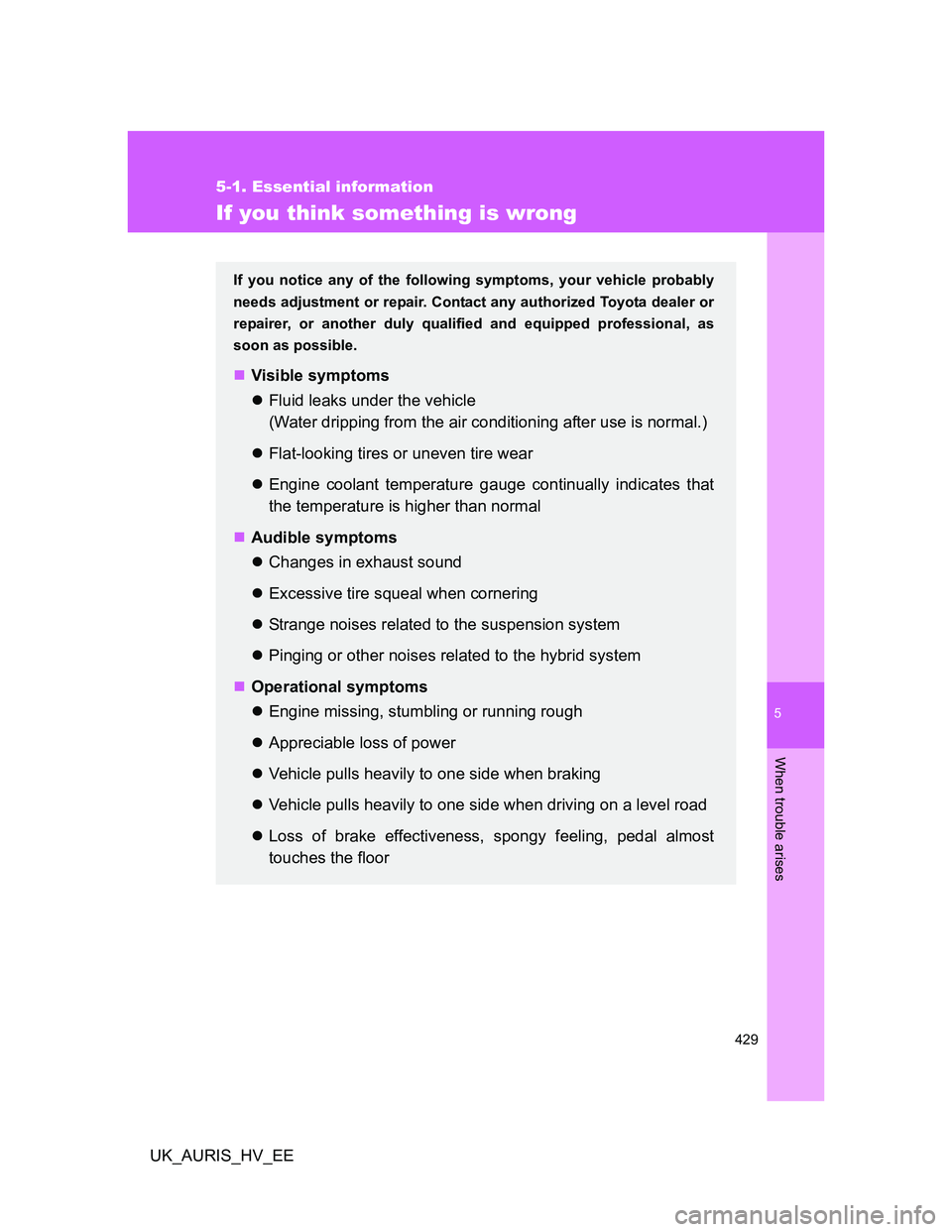
5
429
5-1. Essential information
When trouble arises
UK_AURIS_HV_EE
If you think something is wrong
If you notice any of the following symptoms, your vehicle probably
needs adjustment or repair. Contact any authorized Toyota dealer or
repairer, or another duly qualified and equipped professional, as
soon as possible.
Visible symptoms
Fluid leaks under the vehicle
(Water dripping from the air conditioning after use is normal.)
Flat-looking tires or uneven tire wear
Engine coolant temperature gauge continually indicates that
the temperature is higher than normal
Audible symptoms
Changes in exhaust sound
Excessive tire squeal when cornering
Strange noises related to the suspension system
Pinging or other noises related to the hybrid system
Operational symptoms
Engine missing, stumbling or running rough
Appreciable loss of power
Vehicle pulls heavily to one side when braking
Vehicle pulls heavily to one side when driving on a level road
Loss of brake effectiveness, spongy feeling, pedal almost
touches the floor
Page 430 of 524
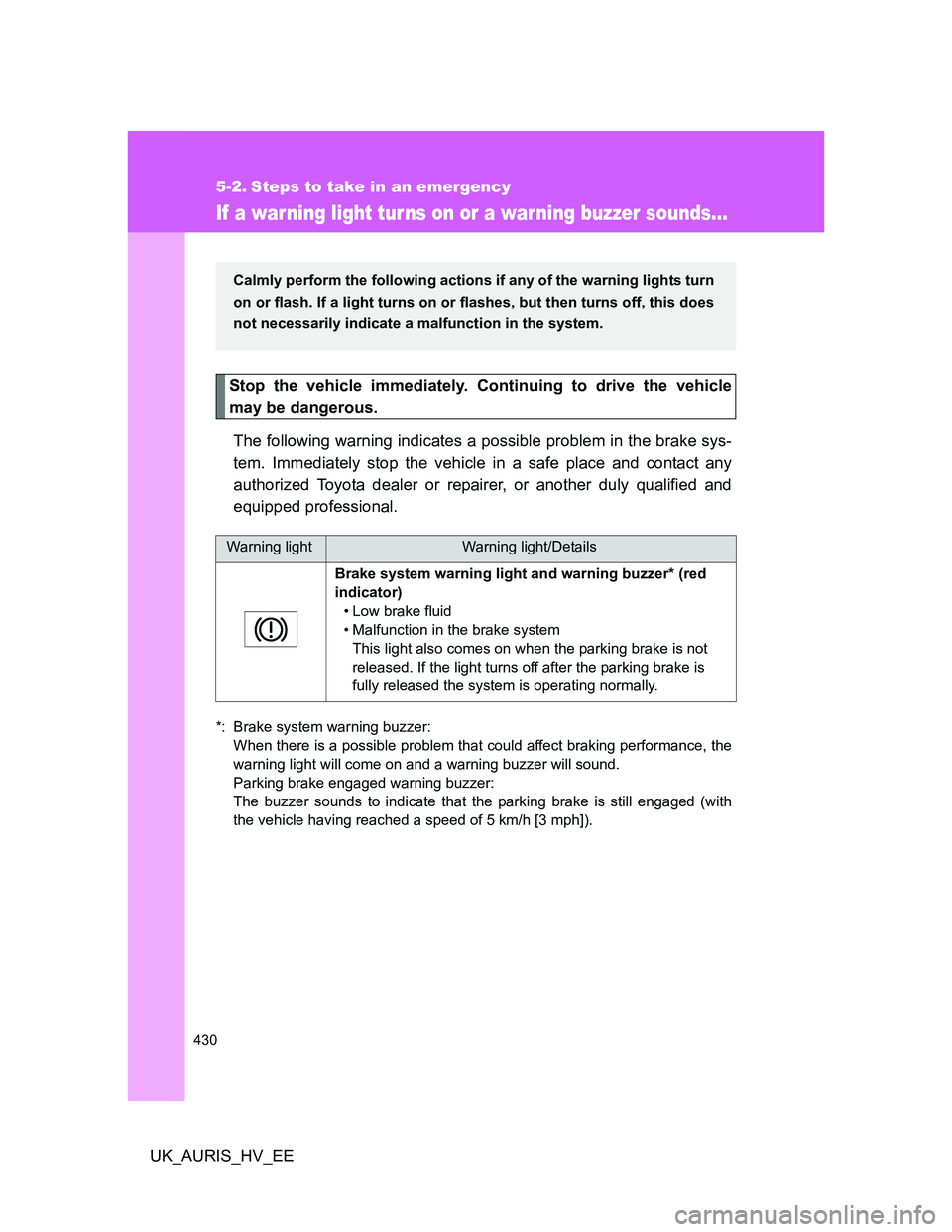
430
UK_AURIS_HV_EE
5-2. Steps to take in an emergency
If a war ning light tur ns on or a warning buzzer sounds...
Stop the vehicle immediately. Continuing to drive the vehicle
may be dangerous.
The following warning indicates a possible problem in the brake sys-
tem. Immediately stop the vehicle in a safe place and contact any
authorized Toyota dealer or repairer, or another duly qualified and
equipped professional.
*: Brake system warning buzzer:
When there is a possible problem that could affect braking performance, the
warning light will come on and a warning buzzer will sound.
Parking brake engaged warning buzzer:
The buzzer sounds to indicate that the parking brake is still engaged (with
the vehicle having reached a speed of 5 km/h [3 mph]).
Warning lightWarning light/Details
Brake system warning light and warning buzzer* (red
indicator)
• Low brake fluid
• Malfunction in the brake system
This light also comes on when the parking brake is not
released. If the light turns off after the parking brake is
fully released the system is operating normally.
Calmly perform the following actions if any of the warning lights turn
on or flash. If a light turns on or flashes, but then turns off, this does
not necessarily indicate a malfunction in the system.